Abstract
The article is devoted to the analysis of different models of terminological units in the language of international law and is based on the texts of 20 internationally recognized documents – International Labour Organization conventions. Due to the fact that conventions apply to different areas of international employment law, the terminology is thematically diverse. The authors distinguish three main types of terms depending on the number of components. Legal terminology is characterized by a certain semantic structure which is of great importance in conveying the meaning of the term. Special attention is given to the ways of legal terminology formation. Though legal English is rather conservative, it allows certain transformations by means of extension of meaning and at the expense of related fields of knowledge. The academic novelty of the presented study consists in its cross-disciplinary nature, its conformity to a new methodological paradigm of modern linguistic research which is based on cross-disciplinary and intradisciplinary relations. Among other ways, transdisciplinary or internal borrowing is described as being the most typical of this sphere of professional language. The lack of consensus among scientists on the unique nature and specificity of this particular subject demonstrates the excessive importance and relevance of our research. Any terminological system, despite its initial clarity, accuracy and belonging to a specific science, is dynamic in nature.
Keywords: International lawILOConventionsLabour Organization
Introduction
The study of interaction and interrelation of language and law has led to the formation of an independent area of research known as legal linguistics which is a relatively new area of research. It is a cross-disciplinary field of study as it combines the study of language and law / law and language in a number of contexts. In some contexts the language aspect prevails over the law (legal translation, legal lexicography, legal rhetoric), but in other contexts law becomes the starting point of research which is focused on legal terminology, the study of legal concepts, their interpretation within national legal systems and legislative drafting. Thus the language is perceived and exploited as a means of understanding, interpreting, and construing the communicative activity in legal sphere, both oral and written.
The language of law has been in the focus of research of various disciplines since ancient Rome and ancient Greece. Besides linguistics, it was analyzed within such fields of knowledge as rhetoric, logics, philosophy, terminology studies. The first dictionary of legal terms – the lexicon was compiled by Gaius Aelius Gallus in the 1st century B.C. and is known under the title De verborum quae ad jus pertinent significatione (“On the meaning of words referring to the law”) (Fiorelli, 1947). Nevertheless, as a separate area of study legal linguistics developed only in the middle of the 20th century. The study of the functional style of legal language and the specifics of its usage was centered on the issues of regulating and generating normative texts. These norms are viewed today as the basis of linguistic expert study of legal and normative acts.
Russian researchers (Baranov, 2007), Golev, 2006), (Kuznetsov, Burdin & Solntseva, 2006) have greatly contributed to the development of legal linguistics. Their research is mainly focused on the analysis of translation equivalence as well as linguistic expert study. The works of foreign researchers are mostly devoted to the language and style of legal documents, appropriateness and equivalence of translating them into national languages, linguistic expert study, pragmatic peculiarities of speech of the participants of judicial proceedings (Coulthard, 1994; Coulthard, Johnson, 2007; Cotterill, 2002).
One of the most diverse studies of the language of law is represented by modern German legal linguistics schools which embrace a wide range of cross-disciplinary research: forensic communication, forensic linguistics, legal argumentation, language norms in law, legal validity of speech acts, legal text interpretation criteria, linguistic requirements to legal wording. There are two main opinions concerning the language of law. The first one supports the idea that there exists a single language of law. U. Daum explains it in the following way: all lawyers use the same language as they obtain similar education which influences the professional language they speak; in all areas of law the language of legal practice is based on the language of legislature which is characterized by the unity of its vocabulary and syntax; there is a profession within the legal profession which greatly influences all spheres of law and uses linguistic means typical of this sphere, and this is the profession of an advocate (Daum, 1981).
Despite the existence of linguistics-based study of the language of law, a number of German researchers do not tend to equate legal language and the language of law pointing out that “the single language of law” does not exist. Since the law is structurally and functionally divided into lawmaking, law-execution and judicial proceedings, each of these areas of law has its own independent language (Eriksen, 1999; Nussbaumer, 1997).
This diverse and multi-dimensional research of the language of law resulted in the development of various linguistic schools, publication of journals and textbooks (Callanan, 2010; Haigh, 2015; Krois-Lindner, 2011), establishment of centers and associations of linguists-experts and further research that views legal language as the prototype of any subject-oriented specialized language (Busse, 1999).
Modern legal linguistics is represented by several sub-genres of legal language based on the varieties of types of lawyers and branches of law, which correlates with the research of German linguistic schools. These include the language of legal authors, legislators (laws and regulations), judges, administrators, advocates, notarial language; terminology of criminal law, land law, tax law, tort law, international law, etc. (Heikki, 2007). Each genre is characterized by its own domain of use and particular linguistic norms (phraseology, vocabulary, hierarchy of terms and meanings). In this regard, it is necessary to point out that legal language possesses a number of specific features. These are morphosyntactic, semantic, and pragmatic (Prieto, 1991). It is not fortuitous that legal language has become a research focus of various areas of linguistic studies as well as cross-disciplinary studies.
One of the approaches to the analysis of legal language is the study of terminology. Understanding English legal terminology and translating it into other languages pose some difficulties because of the incongruity of legal systems which is stipulated by historical development and represents the specifics of legal thinking and ideology of different countries.
The study of the language of law would be incomplete without taking into consideration recent methods and models of text analysis which are widely used in quantitative and corpus linguistics. For the purpose of this study, the authors find it reasonable to use context-based approach alongside statistical methods which allow one to automatically single out terms from the texts and rank them according to the structural models proposed by the authors.
The presented article is a part of a wider project carried out by the Chair of English Language and Professional Communication at Pyatigorsk State University (Pyatigorsk, Russia) which is aimed at conducting multifaceted linguistic analysis of legal English. The project focuses on the following major objectives: checking contextual compatibility of lexical-semantic units in the language of international law; identifying terminological models and types; developing a linguistic model of legal English through the analysis of morphological-syntactic, semantic, and pragmatic specifics of the language of law. The article describes the results of the second stage of the project.
The outcome of the study is a reliable bilingual (English-Russian) terminology resource, a Database of the terms of international law which contains 500 entries defining the type of term model, the field of knowledge the term belongs to, and the sphere of usage. The database is supposed to be interconnected with other databases developed in the course of the research conducted under the project. The first database has already been drawn by one of the authors of the article and at present is undergoing the registration process in the Russian patent agency “Rospatent” (“Database of English bigrams-collocations of the sphere of international law” compiled by O.M. Litvishko).
Considering the creation of a database as the main objective of the study, the authors set out the following tasks:
to choose the material for research;
to develop a corpus comprised of the texts from the sphere of international law, namely, the texts of the conventions of International Labour Organization;
to study the material to single out specific terminological units belonging to the sphere of law;
to analyze the terminological units to define their structural peculiarities;
to classify the terminological units according to the existing terminological models;
to work out the database of legal terms from the sphere of international law;
to do analysis and synthesis of the results;
to publish the results in the format of a research article.
The academic novelty of the presented study consists in its cross-disciplinary nature, its conformity to a new methodological paradigm of modern linguistic research which is based on cross-disciplinary and intradisciplinary relations.
Problem Statement
The study is based on the texts of the following conventions of the International Labour Organization (ILO):
C029 - Forced Labour Convention;
C050 - Recruiting of Indigenous Workers Convention;
C065 - Penal Sanctions (Indigenous Workers) Convention;
C087 - Freedom of Association and Protection of the Right to Organise Convention;
C088 - Employment Service Convention;
C090 - Night Work of Young Persons (Industry) Convention (Revised);
C095 - Protection of Wages Convention;
C100 - Equal Remuneration Convention;
C102 - Social Security (Minimum Standards) Convention;
C105 - Abolition of Forced Labour Convention;
C111 - Discrimination (Employment and Occupation) Convention;
C128 - Invalidity, Old-Age and Survivors' Benefits Convention;
C138 - Minimum Age Convention;
C154 - Collective Bargaining Convention;
C155 - Occupational Safety and Health Convention;
C157 - Maintenance of Social Security Rights Convention;
C158 - Termination of Employment Convention;
C161 - Occupational Health Services Convention;
C171 - Night Work Convention;
C177 - Home Work Convention [International Labour Organization].
The collection of conventions includes the texts of 20 internationally-recognized documents with a total number of words of 60859. The choice of conventions for the study is guided by two considerations. Firstly, the study material includes seven core conventions ratified by the majority of countries (conventions C029, C087, C100, C105, C111, C138, C154). Secondly, other 13 chosen conventions are universal and can be applied to any field or industry. They represent various types of employment and are related to the rights and obligations of both employers and employees.
Research Questions
The study involves several areas of linguistics – lexicology, lexicography, terminology studies, legal linguistics, with elements of quantitative and corpus linguistics. This allows the authors to implement a number of approaches, methods and techniques widely used by the areas of linguistics mentioned above. They include content-analysis and genre analysis (Legal linguistics, 2000), diversified search, frequency distribution, continuous sampling method (quantitative linguistics), semantic component analysis, descriptive method (lexicology). Using all these methods leads to the identification of terminological units with further analysis of their structural models. Data obtained in the course of the study are subject to being classified with the help of statistical method.
Using statistical method in text analysis appears to be of immediate interest when a new field of study is being developed, or when terminological system is being altered. This allows the researcher to highlight and evaluate terminological patterns. Legal linguistics, being a new area of linguistics, possesses extensive study material which has not been included into statistical text studies yet.
Purpose of the Study
As it was stated in the paper, despite numerous scientific works on the theory of terms and terminological systems, there is a wide range of debatable issues. We believe that the lack of consensus among scientists on the unique nature and specificity of this particular subject demonstrates the excessive importance and relevance of our research.
Research Methods
Regardless of disagreements among researchers as to the nature and basic features of the term, the positions of the majority of scientists do not contradict, but complement each other, since many recognize such characteristics of the term as: clarity, accuracy, brevity, systemacity, stylistic neutrality, lack of modal and stylistic function, indifference to the context, absence of synonyms and homonyms within one terminology system (Reformatsky, 1961; Lotte, 1986; Danilenko, 1993; Leychik, 1973; Tolikina, 1970; Moiseyev, 1970; Superanskaya, 2012; Golovin & Kobrin, 1987; Grinev, 1993; Petrova, 1987).
However, this is more a characteristic of an “ideal” term that does not exist in practice; in fact, it is sensible to single out a number of obligatory properties of terms, among them: clarity, brevity, systemacity and compliance with the norms of a certain language. These basic features are taken into account in the study.
Moreover, many specialists think that the term comprises three dimensions such as linguistic, cognitive and social (Sager, 1990; Temmerman, 2000; Jackendoff, 2002). It can be the explanation for the wide range of interpretations of terms existing at present. These interpretations can be summarized as follows: a) for linguistics, terms are specialized according to topical, pragmatic and semantic criteria; b) for special subjects, terms are a means of professional communication representing knowledge within special areas.
Summing everything up we would like to emphasize once again the crucial importance of terms in the language. We absolutely share the idea that in the process of any communication, terms serve as vital pieces of information which guarantee understanding (Tolikina, 1970). Only with the help of an adequate term, people are able to shape thoughts and improve their knowledge in a specific field.
Findings
Classification of terms models
In the course of the analysis of the terms of the sphere of law, the semantic classification of terms, proposed by O.A. Alimuradov, M.N. Latu, A.V. Razduev is of great importance (Alimuradov, Latu, & Razduev, 2011). According to the scientists, every term has a heterogeneous semantic structure, marked by the presence of a “nuclear area” and a “peripheral area”. Thus, the “nuclear area” is understood as the “semantic core of the term”, while the “peripheral area” represents the additional semantic information. Investigating the terminology of nanotechnologies, the authors differentiate three types of terms: single-core terms consisting of one nucleus, binuclear terms, and also units that imply the presence of a semantic core and periphery. It is obvious that this classification is quite applicable to the legal terminology, however, the authors decided to supplement the existing model and analyze the corpus of terms of law with the emphasis on their parts of speech representation and the number of components within each specific terminology element.
An empirical analysis of linguistic material allows the authors to talk about the existence of at least three structural models of legal terms: one-component, two-component and multicomponent. We note at once that, as the main criterion for distinguishing components within a terminological unit, the authors considered the gap between words. Of course, each structural model of terms has its frequency of verbalization in the scale of the analyzed texts of ILO Conventions, as shown in Diagram 1 (Fig. 1) in point C of the results of the study.
Let us turn to a more detailed analysis of the structural models of legal terms.
To one-component terms we refer terms consisting of one element representing the semantic nucleus, usually a noun, for example: discrimination, adoption, complaint, pension, etc.
Two-component terms (the most numerous model) have two elements in their structure and are mostly formed with the help of Adj. + N. scheme: collective agreement, human rights, illegal exaction, preventive measures, etc. In fact, each element of these terms is semantically important as it gives significant information about a certain thematic / professional sphere, so in this case we deal with the terms consisting of two nuclear areas.
Multicomponent terms consist of three and more elements, which include different parts of speech (nouns, adjectives, verbs, articles, etc.), for example: safe working environment, terms and conditions of employment, economically active population, general level of earnings, present one's claim, meet the requirements, etc. As for the multicomponent terms, we point out both nuclear and peripheral areas within them, e.g.: present one's claim – claim serves as a nuclear part, present one’s – periphery; meet the requirements – requirements – nuclear part, meet the – periphery, etc.
Affiliations of authors should be typed in 9-point Times. They should be preceded by a numerical superscript corresponding to the same superscript after the name of the author concerned. Please ensure that affiliations are as full and complete as possible and include the country.
Ways of terms formation
In the course of the analysis of the conventions of the ILO, it was observed that legal terminological units fixed in documents belong to other spheres, such as economics, politics, medicine, etc., in terms of their basic lexical meaning.
Thus in the texts of conventions, we see a number of economic terms, which is confirmed by their vocabulary definitions, in the paper we give only a few: salary – a fixed regular payment, typically paid on a monthly basis but often expressed as an annual sum, made by an employer to an employee, especially a professional or white-collar worker; tax – a compulsory contribution to state revenue, levied by the government on workers' income and business profits, or added to the cost of some goods, services, and transactions; employment – the state of having paid work (Oxford Dictionaries, 2000).
This tendency is absolutely logical and can be easily explained. Here we need to take into account the basic mechanisms of term formation which are recognized in linguistics (Valeontis & Mantzari, 2006):
creating new forms;
using existing forms;
translingual borrowing
The first and the third methods of term formation (creating new words and translingual borrowing) are not so widely spread in the sphere of law in general and in the texts of the ILO, in particular, due to its conventional and conservative nature and tight connection to the deep-rooted issues with long history. On carrying out the research, we came across a few examples (such as: ipso jure, inter alia) of borrowings from the Latin language, which had a great influence on further development of legal sphere.
In the paper we pay our special attention to the second way of term formation which many scientists define as transdisciplinary borrowing or internal borrowing (Valeontis & Mantzari, 2006). It refers to situations where a designation from one specific subject field is used in another one in order to represent a different concept.
Here are some examples:
The contingencies covered shall include any morbid condition, whatever its cause, and pregnancy and confinement and their consequences.
The first widely used in legal sphere definition of the word confinement is as follows: the situation in which a person or animal is kept somewhere, usually by force, but in the text of the ILO Convention the same word confinement is used in its purely medical sense and means the process of giving birth to a baby.
A worker whose employment has been terminated shall be entitled, in accordance with national law and practice, to benefits from unemployment insurance or assistance or other forms of social security, such as old-age or invalidity benefits, under the normal conditions to which such benefits are subject.
In example (2) we find the word invalidity which is used in different fields of knowledge: (Economics) invalidity – the condition of being too ill to work and acre for yourself; (Law / relating to documents) invalidity – the condition of not being legally or officially acceptable; (Law / The ILO Convention) invalidity – the condition of being unable to work because of health problems, and receiving money from a government or organization because of this.
These are just several cases of transdisciplinary borrowing within our sample.
Besides, one of the most important tasks of this study is the quantitative analysis of the frequency of the representation of terms of a particular subject area within our sample on the ILO conventions (the distribution of terms by subject area is presented in the diagram (Fig. 2) in point C of the results of the study).
To sum up we need to state that any terminological system, despite its initial clarity, accuracy and belonging to a specific science, is dynamic in nature (Kageura, 2002), since it allows certain transformations, extension of meaning and enlarging of the terminological apparatus, including, at the expense of related branches of knowledge.
Development of the database
The final result of our research is the development of an electronic database of English terms of the legal sphere, which numbers 500 terminological elements. To create the database, we used the Microsoft Access program, which allows one to fully systematize and structure any given information. The fragment of the database developed by the authors is presented in point C of the results of the study (Fig. 3, Fig. 4, Fig. 5).
Electronic database of legal terms is a table consisting of 500 titles, arranged in alphabetical order. Each name in the database is subjected to a detailed analysis, including such aspects as:
• the English-language term, as recorded in the texts of the ILO conventions;
• translation / equivalent of the term in Russian;
• a partial representation of a terminological unit;
• the priority sphere of term use;
• number of components;
• contextual use of the terminological unit.
The listed characteristics of the terms are not complete, however, according to the authors, they correspond to the aims and objectives of the research and serve as a sufficiently valid basis for distinguishing specific lexemes as terminological units of the legal sphere in the area of international law.
Conclusion
As a result of the study, the authors came to the following conclusions:
The significance of the study of legal terminology
Active participation of the population in various legal relations stipulates the necessity of working out universal interpretation of legal norms and terms. It is impossible without linguistics in general and legal linguistics in particular, the subject of which is the intersection of law and language.
The language of law is now one of the most highly demanded and pressing research subjects. It is also very popular among the public, which foregrounds further research within the given topic. Differences in legal systems stipulated by historical development of law make it difficult to cope with the problem of terminological variability, even in the sphere of international law. The solution to the problem lies in the study of terminological models and development of generally accepted methods of translating legal terms and compiling specialized databases and dictionaries, which is one of the research subjects of legal linguistics.
The study conducted by the authors of the article is an attempt to work out a translation tool which may be of great interest both to linguists and lawyers, as well as the public, as it presents not only the translation of the terms into Russian but also the description of their contextual usage and structural specifics according to several structural models defined by the authors.
The authors consider the terms the essential part of any communication in any given language and stick to the idea that these words are aimed at a better understanding and more profound knowledge in a certain subject matter. They recognize such characteristics of the term as: clarity, brevity, systemacity and compliance with the norms of a certain language.
Structural peculiarities of terms
Structural models
Within the legal terminology system there are three models of terms: one-component, two-component and multicomponent. One-component terms are represented mostly by nouns (for example, offence, penalty), two-component terms are formed according to the scheme Adj. + N. (for example, competent authority, compulsory labor), multicomponent terms consisting of three and more elements are phrase complexes, in which, along with nominal forms, there are also verbal (for example, commit a crime, ratify the Convention).
Semantic structure
Legal terms have a semantic structure, which is characterized by the presence of “nuclear” and “peripheral” areas that convey the entire conceptual meaning of the term.
Denotation of terms
The analysis of the texts of the conventions of the ILO has shown that in legal documents there are thematically diverse terms operating in the field of Economics, Medicine, Social Science, Political Science and having a different frequency of use, which is confirmed statistically.
Terminological database
Within the framework of the research, the electronic database of English terms of the legal sphere, numbering 500 terminological units, was developed and registered in the Office of Innovative-technological and project-oriented business activity of Pyatigorsk State University (Pyatigorsk, Russia). The database is of great practical value due to its dynamic nature and openness. It can be used by both legal professionals and ordinary citizens willing to have more profound knowledge of international employment law and be better equipped with legal issues.
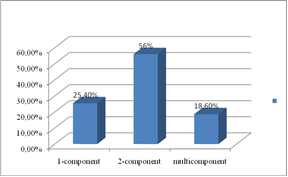
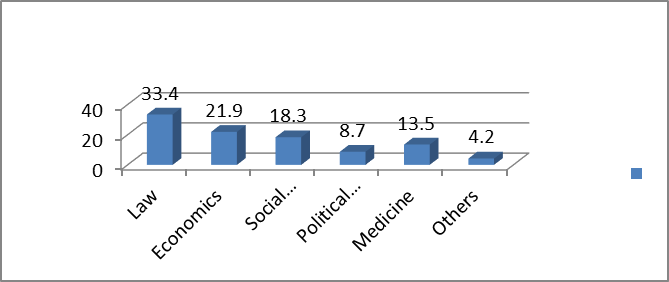
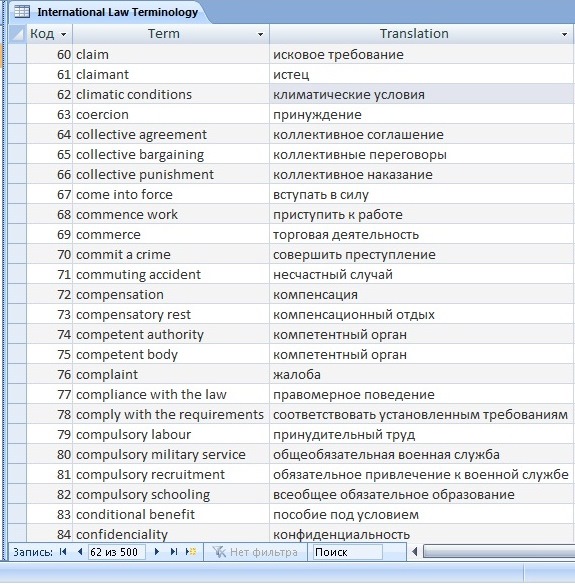
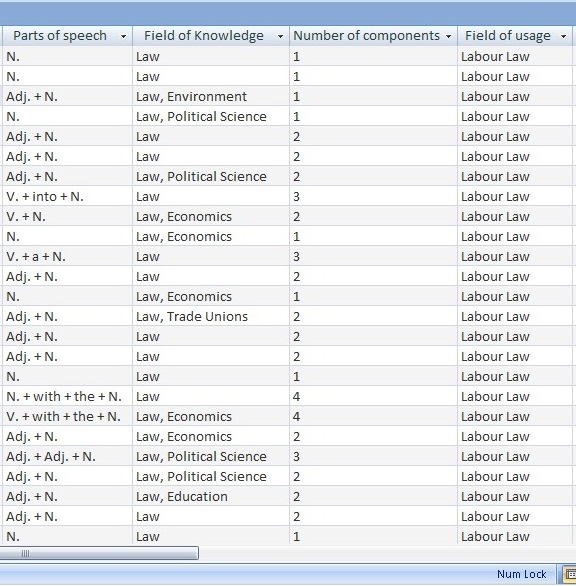
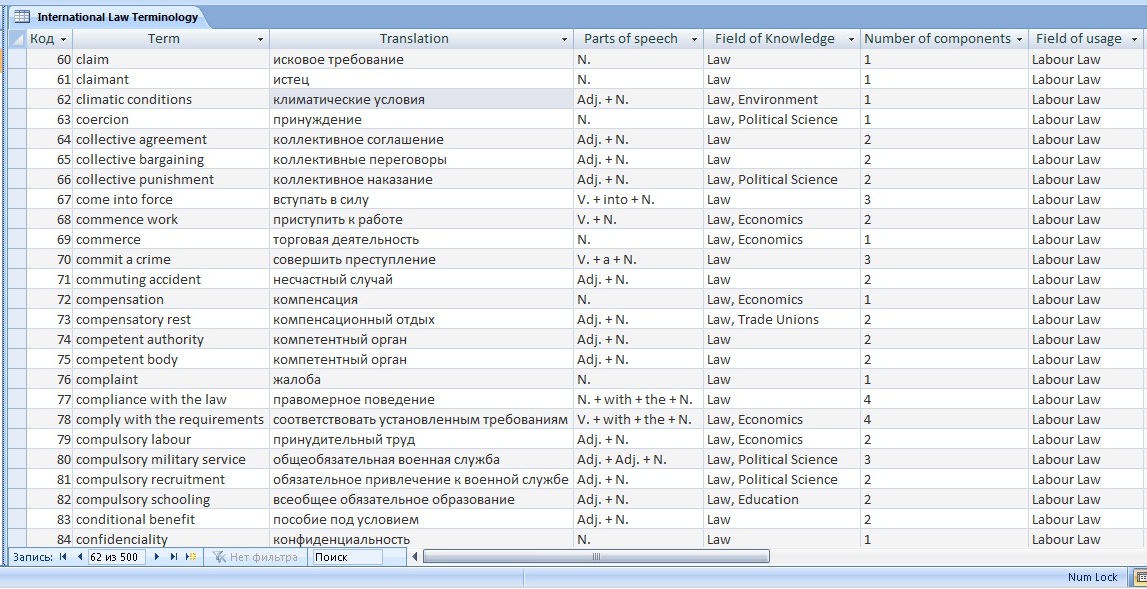
References
- Alimuradov, O.A., Latu, M.N., Razduev A.V. (2011). Features of structure and functioning of terminology (On the example of a terminology system of nanotechnologies). Pyatigorsk: Sneg
- Baranov, A.N. (2007). Linguistic expert study of the text: theoretical underpinnings and practice. Moscow: Flinta Nauka
- Busse, D. (1999). Die juristische Fachsprache als Institutionensprache am Beispiel von Gesetzen und ihrer Auslegung, Fachsprachen. [The legal jargon as an institutional language using the example of laws and their interpretation, technical languages]. Ein internationals Handbuch zur Fachsprachenforschung und Terminologiewissenschaft. 2, 1382-1390.
- Callanan, H., Edwards, L. (2010). Absolute Legal English. London: Delta Publishing.
- Cotterill, J. (2002). Language in the legal process. New York: Palgrave Macmillan.
- Coulthard, M. (1994). Advances in written text analysis. New York: Routledge.
- Coulthard, M., Johnson, A. (2007). An Introduction to Forensic Linguistics: Language in Evidence. London, New York: Routledge.
- Danilenko, V.P. (1993). Linguistic aspect of terminology standardization. Moscow: Nauka
- Daum, U. (1981). Der oeffentliche Sprachgebrauch, II, 58-61
- Eriksen, L. (1999). Einführung in die Systematik der juristischen Fachsprache, Juristische Fachsprache [Introduction to the system of jurisprudence]. In Kongressberichte des 12th European symposium on language for special purposes (pp. 1-19). Bruxelles, Bressanone, , Münster: LIT Verlag.
- Fiorelli, P. (1947). Rivista Ital. per le Sci. Giur. I, 293-327
- Golev, N.D. (2006). Leg. Ling. 7, 8-38
- Golovin, B.N., Kobrin, R.Yu. (1987). Linguistic basis of the doctrine of terms. Moscow: Visshaya shkola.
- Grinev, S.V. (1993). Introduction to terminology. Moscow: Moskovsky litsey
- Haigh, R. (2015). Legal English. New York: Routledge
- Heikki, E., Mattila, S. (2007). Comparative legal linguistics. Ashgate Publishing
- Jackendoff, R. (2002). Foundations of Language. Oxford/New York: Oxford University Press.
- Kageura, K. (2002). The Dynamics of Terminology. Amsterdam/Philadelphia: John Benjamins
- Krois-Lindner, (2011). International legal English. Cambridge: University Press
- Kuznetsov, A.M., Burdin, L.S., Solntseva, N.V., (2006). Legal linguistics: language and law: scientific-analytical overview. Moscow: INION.
- Legal Linguistics (2000). Yurislingvistika. Retrieved from http://journal.asu.ru/index.php/urisl
- Leychik, V.M. (1973). Terms-synonyms, doublets, equivalents, variants. Actual problems of lexicology and word formation. vol. II, Novosibirsk
- Lotte, D.G. (1986). How to work on terminology. Fundamentals and methods. Moscow: Nauka.
- Moiseyev, A.I. (1970). On the linguistic nature of the term. Linguistic problems of scientific and technical terminology. Moscow: Nauka
- Nussbaumer, M. (1997). Sprache und Recht. Heidelberg: Groos
- Oxford Dictionaries, (2000) Retrieved from https://en.oxforddictionaries.com
- Petrova, I.L. (1987). On some special conditions of the functioning of terms. Terms in language and speech, 43, 98-106.
- Prieto, P.J. (1991). Lenguas, lenguaje y derecho. Madrid: Editorial Civitas
- Reformatsky, A.A. (1961). What is the term and terminology. Questions of terminology, 11, 16-23.
- Sager, J.C. (1990). A Practical Course in Terminology Processing. Amsterdam/Philadelphia: John Benjamins.
- Superanskaya, A.V.(2012). General terminology: Theoretical questions. Moscow: LIBROKOM
- Temmerman, R. (2000). Towards New Ways of Terminology Description. The sociocognitive approach Amsterdam. Philadelphia: John Benjamins.
- Tolikina, E.N. (1970). Some linguistic problems of the term. Moscow: Lingva.
- Valeontis, K., Mantzari, E., (2006). The linguistic dimension of terminology: principles and methods of term formation. In Maraslis S. (Ed.) 1st Athens International Conference on Translation and Interpretation Translation: Between Art and Social Science. Athens: HAU..
Copyright information

This work is licensed under a Creative Commons Attribution-NonCommercial-NoDerivatives 4.0 International License.
About this article
Publication Date
29 March 2019
Article Doi
eBook ISBN
978-1-80296-057-0
Publisher
Future Academy
Volume
58
Print ISBN (optional)
-
Edition Number
1st Edition
Pages
1-2787
Subjects
Sociolinguistics, linguistics, semantics, discourse analysis, science, technology, society
Cite this article as:
Litvishko, O., & Miletova, E. (2019). Structural Peculiarities Of Terminological System Of International Law (Based On Ilo Conventions). In D. K. Bataev (Ed.), Social and Cultural Transformations in the Context of Modern Globalism, vol 58. European Proceedings of Social and Behavioural Sciences (pp. 2324-2335). Future Academy. https://doi.org/10.15405/epsbs.2019.03.02.268
